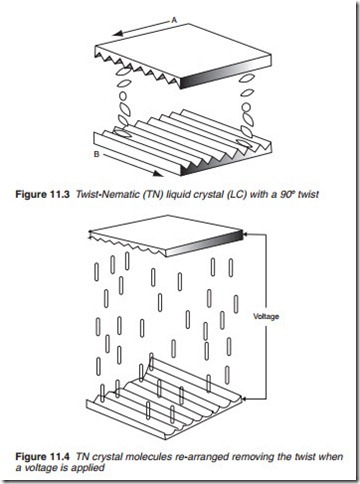Liquid crystal display (LCD)
Liquid crystal display (LCD) units used for the purposes of moving pic- ture reproduction are some of the more popular flat panel displays. Like all flat panel displays, LCDs employ a matrix structure in which the active element, in this case a liquid crystal (LC), forming the pixel cell is located at the intersection of two electrode buses.
So, what is a liquid crystal? An LC is neither crystal nor liquid. It exhibits liquid-like as well as crystal-like properties. This feature is a result of the LC’s comparatively elongated molecules and their structure. Though an LC is a natural material, the liquid crystal which is used for LC displays is a multi-component mixture that is artificially created by blending of biphenyl, cyclohexane, ester and the like.
Polarisation
Light is a transverse electromagnetic (EM) wave composed of an electric and a magnetic field. The two fields are at right angles to each other travelling at the speed of light. In an EM wave, the electric field defines the designation of the wave in terms of its polarisation: if the electric field is vertical, the wave is said to be vertically polarised or ‘p-polarised’ (Figure 11.1) and con- versely if the electric field is horizontal, the wave is said to be horizontally polarised or ‘s-polarised’. Natural light from the sun or any other light source such as a lamp is unpolarised. It contains both vertical and horizontal polar- isation. Light may become polarised if the vertical or horizontal polarisation is reduced or removed completely by, for instance a polarising filter, the type used in Polaroid sunglasses. If the horizontal polarisation is removed, the light would be vertically polarised and vice versa. This simple principle is used to control the brightness of an LC cell.
Principles of operation of LC cell
By themselves, the molecules in an LC are arranged in a loose order. However, when they come into contact with a finely grooved surface, the molecules line up in parallel along grooves of alignment layer as shown in Figure 11.2.
Furthermore, the application of an electric field across the LC causes a change in the molecular structure. This change affects the optical proper- ties of the crystal in the way light is reflected off it or passes through it.
The most popular type of LC is the Twist-Nematic (TN). In this mode, the grooves in the two plates are at right angles as shown in Figure 11.3. The molecules along the upper plate point in direction ‘A’ and those along the lower plate in direction ‘B’ thus forcing the molecules of LC to arrange themselves in a helical form. The helix has the effect of twisting the EM wave (light) passing through it by 90º. Thus, if a vertically polarised light is forced through such a crystal, it will suffer a 90º twist and become hor- izontally polarised. However, what is special about LCs is that if an elec- tric field is applied across it (Figure 11.4), the helical structure begins to break down and with it the polarisation of light resulting in a smaller twist than the natural 90º. The voltage level determines the extent to which
breakdown occurs and the amount of twist. If a high enough voltage, in the region of 8 V, is applied, the twist is eliminated completely.

